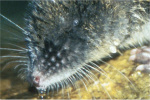Imagine, forty million years ago a great tropical storm rises up on the eastern coast of Africa. Hundreds of trees are blown over and swept out to sea, but one harbors something special: inside a dry hollow rests a small lemur-like primate. Currents carry this tree and its passenger hundreds of miles until one gray morning it slides onto a faraway, unknown beach. The small mammal crawls out of its hollow and waddles, hungry and thirsty, onto the beach. Within hours, amid nearby tropical forests, it has found the sustenance it needs to survive: in a place that would one day be named Madagascar.
The world’s fourth largest island, Madagascar is home to some of world’s most unique and bizarre wildlife, including more than 100 species of the much-loved lemur. But how did such animals reach the island, 300 miles from the African mainland? A new study published in Nature has uncovered the dramatic answer.
 Long ago ancestor of the Diademed Sifaka (Propithecus diadema) lemur reached Madagascar by riding natural rafts, according to a new study. Photo by: Rhett A. Butler. |
The researchers, Professors Matthew Huber of Purdue and Jason Ali of the University Hong Kong, write that species rode out to Madagascar on natural rafts, such as trees, which were blown out to sea. After surviving a harrowing, yet (according to the researchers) feasible trip, the immigrants would have reached the shores of their new home and propagated.
Using a computer simulation of ocean currents during that time, the researchers argue that the long migration would have been possible. The animals that reached the island would then have evolved in complete isolation over millions of years into the odd forms that survive today, such as the long-fingered aye-aye and the world’s tiniest chameleon.
Today, currents between Africa and Madagascar flow south and southwest—not east—making such rafting trips impossible. However according to the complex computer simulation, currents flowed eastward between 20 to 60 million years ago, the pivotal period when researchers say terrestrial species arrived in Madagascar. In addition, these currents were fast enough to bring animals across the 300 miles before they would have perished from thirst. As well, Madagascar’s fauna are all small-bodied and capable of long periods of dormancy, raising the chances of the success of their journey. The scientists argue that some of the animals may have been swept out into sea during hibernation, which would increase their chances of survival, since hibernating animals require little food or water.
The other theory of how Madagascar was populated entails a landbridge connecting Africa to Madagascar. However there is no physical evidence of such a landbridge and the land bridge hypothesis should mean that Madagascar would also contain large-bodied vertebrates, such as ancestors of giraffes, elephants, cats, and dogs. But, of course, there is no record of any such animals reaching the island.
“I was very excited to see this paper,” says Anne Yoder director of the Duke University Lemur Center and a reviewer of the study. “Dispersal [byway of rafts] has been a hypothesis about a mechanism without any actual data. This takes it out of the realm of storytelling and makes it science.”
Madagascar is second only to Australia in terms of its number of endemic, i.e. unique, species, but is thirteen times smaller than Australia.
Editor’s note: the number of lemur species found in Madagascar has been updated from 70 to more than 100 and the text claiming the absence of hippos, which indeed were present on Madagascar until recent times, has been corrected. We apologize for the errors.
Related articles
Forgotten species: Madagascar’s water-loving mammal, the aquatic tenrec

(11/12/2009) There are many adjectives one could attach to the aquatic tenrec: rare, mysterious, elusive, one-of-a-kind, even adorable, though one tries to stray from such value-laden titles since it excludes so many other non-adorable inhabitants of the animal kingdom. This small and, yes, cute insectivore, also known as the web-footed tenrec, lives in Eastern Madagascar where at night it spends the majority of its time swimming and diving in fast-moving streams for insects and tadpoles. It sleeps during the day in small streamside burrows. To date that is about the extent of our knowledge of this species.
Good news for the rarest lemur
(10/07/2009) A scientific expedition has found one of the Madagascar’s rarest lemurs in a region where it was once thought to be extinct, report conservationists.
Approximately 200 new frogs discovered in Madagascar threatened by political instability

(05/11/2009) Amid the amphibian extinction crisis—where amphibians worldwide are disappearing due to habitat loss, pollution, and a devastating fungal epidemic—the Spanish Scientific Research Council (CSIC) has announced some good news. In a survey of the island-nation of Madagascar they have identified between 129 and 221 new species of frogs. The discovery of so many new species nearly doubles the island’s total number of frogs.














